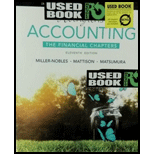
Concept Introduction:
Relevant or avoidable costs and Irrelevant or unavoidable costs –
The major decisions that a business has to take during its operations include dropping of a product, elimination of a segment, buy or make a product, to sell at scrap or rework on the product, to accept special offers etc. All these decisions are taken on the basis of the costs involved. There are two types of costs –
1. Relevant costs or avoidable costs – these costs can be defined as the costs that can be avoided if we choose over option over the other. Example of relevant costs are, direct material, direct labor, avoidable fixed costs etc.
2. Irrelevant costs – these costs can be defined as the costs that cannot be avoided in any of the options available or the costs which have been already incurred like sunk costs. Examples of irrelevant costs are unavoidable fixed costs, or the costs which have been already incurred.
Requirement 1
To prepare:
The analysis explaining should Wild ride make or buy the bindings
Requirement 2
To show:
The alternative that makes best use of Winter Sport’s facilities –
(a) Make bindings
(b) Buy bindings and leave facilities idle
(c) Buy bindings and make another product
Want to see the full answer?
Check out a sample textbook solution
Chapter 25 Solutions
Horngren's Accounting, The Financial Chapters (11th Edition) - Standalone Book
- Einstein Corporation has budgeted a total overhead cost of $720,000 and budgeted machine hours of 60,000 for the upcoming period. During the actual period, the total overhead incurred was $750,000, and actual machine hours used were 65,000. Find the applied overhead for the period and determine whether the overhead is overapplied or underapplied. Show your step-by-step solution.arrow_forwardGhana company reported inventory of $60,000 at the beginning of 2023.arrow_forwardI am searching for the correct answer to this general accounting problem with proper accounting rules.arrow_forward
- Given the solution and financial accounting questionarrow_forwardArmour vacation cabin was destroyed by a wildfire. He had purchased the cabin 14 months ago for $625,000. He received $890,000 from his insurance company to replace the cabin. If he fails to rebuild the cabin or acquire a replacement property in the required time, how much gain must he recognize on this conversion? A. $375,000 B. $160,000 C. $265,000 D. $0 E. None of the above provide answerarrow_forwardCan you solve this general accounting question with accurate accounting calculations?arrow_forward
- Hello tutor please given General accounting question answer do fast and properly explain all answerarrow_forwardCan you explain the correct approach to solve this financial accounting question?arrow_forwardPlease help me solve this financial accounting problem with the correct financial process.arrow_forward

 AccountingAccountingISBN:9781337272094Author:WARREN, Carl S., Reeve, James M., Duchac, Jonathan E.Publisher:Cengage Learning,
AccountingAccountingISBN:9781337272094Author:WARREN, Carl S., Reeve, James M., Duchac, Jonathan E.Publisher:Cengage Learning, Accounting Information SystemsAccountingISBN:9781337619202Author:Hall, James A.Publisher:Cengage Learning,
Accounting Information SystemsAccountingISBN:9781337619202Author:Hall, James A.Publisher:Cengage Learning, Horngren's Cost Accounting: A Managerial Emphasis...AccountingISBN:9780134475585Author:Srikant M. Datar, Madhav V. RajanPublisher:PEARSON
Horngren's Cost Accounting: A Managerial Emphasis...AccountingISBN:9780134475585Author:Srikant M. Datar, Madhav V. RajanPublisher:PEARSON Intermediate AccountingAccountingISBN:9781259722660Author:J. David Spiceland, Mark W. Nelson, Wayne M ThomasPublisher:McGraw-Hill Education
Intermediate AccountingAccountingISBN:9781259722660Author:J. David Spiceland, Mark W. Nelson, Wayne M ThomasPublisher:McGraw-Hill Education Financial and Managerial AccountingAccountingISBN:9781259726705Author:John J Wild, Ken W. Shaw, Barbara Chiappetta Fundamental Accounting PrinciplesPublisher:McGraw-Hill Education
Financial and Managerial AccountingAccountingISBN:9781259726705Author:John J Wild, Ken W. Shaw, Barbara Chiappetta Fundamental Accounting PrinciplesPublisher:McGraw-Hill Education





